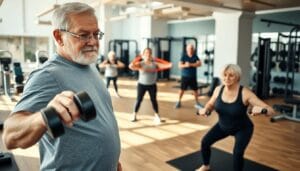Staying active is crucial for maintaining health and independence, especially as we age. Yet, statistics show that only 15% of adults aged 65-74 engage in regular physical activity. For those with limited mobility, finding safe ways to stay active can be challenging.
Inactivity can lead to serious health risks, including muscle loss, poor blood sugar control, and reduced balance. However, there’s good news: chair-based activities offer a safe and effective way to stay fit. These routines can improve strength, enhance balance, and even boost walking ability.
According to physical therapist Tobi Jevnikar, maintaining muscle mass is essential for older adults. Studies show that regular chair routines can increase strength by 23%. These activities also address risks like osteoporosis and heart disease, making them ideal for those aged 65 and above.
Whether you’re looking to strengthen your legs, improve your core, or enhance your balance, chair-based activities provide a versatile solution. They’re perfect for older adults, including those who use assistive devices.
Key Takeaways
- Only 15% of adults aged 65-74 engage in regular physical activity.
- Inactivity can lead to muscle loss and poor blood sugar control.
- Chair-based activities improve strength, balance, and walking ability.
- These routines are safe for older adults, including assistive device users.
- Regular chair activities can increase strength by 23%.
Introduction to Seated Exercises for Seniors
Chair-based workouts are a practical solution for maintaining mobility and strength. These routines are designed to be accessible, requiring no gym membership or special equipment. They focus on improving daily tasks like vacuuming, laundry, or walking short distances.
Unlike standing activities, which can enhance bone density, chair exercises are gentler on the joints. They target key muscle groups, including the arms, shoulders, core, hips, and legs. This makes them ideal for older adults with limited mobility.
For those using walkers or wheelchairs, modifications are available to ensure safety and effectiveness. A stable, armless chair is essential, along with simple items like a pillow or canned goods for added weight.
Experts recommend dedicating at least 15 minutes daily to these routines. However, it’s crucial to avoid wheeled or folding chairs, as they can pose safety risks.
| Muscle Group | Benefits |
|---|---|
| Arms | Improves grip strength and daily functionality |
| Shoulders | Enhances range of motion and posture |
| Core | Supports balance and reduces back pain |
| Hips | Increases flexibility and stability |
| Legs | Boosts walking ability and endurance |
Why Seated Exercises Are Effective for Seniors
Physical activity plays a vital role in preventing age-related health issues. For older adults, maintaining strength and balance is essential to reduce the risk of falls and improve overall health. Research shows that just two weeks of inactivity can lead to irreversible muscle loss, a condition known as sarcopenia.
Resistance training, even in a seated position, helps combat sarcopenia. Simple movements like pelvic tilts and shoulder blade squeezes improve posture and alignment. These activities also enhance circulation, reducing the risk of heart disease. Franklin Antoian, a fitness expert, emphasizes the importance of safe weight-bearing alternatives for those with limited mobility.

Seated marches are another effective way to maintain hip mobility. This movement not only strengthens the lower body but also supports daily tasks like rising from chairs or reaching overhead. A 2023 study in the Journal of Gerontology found that regular chair-based activities reduced fall risk by 30%.
For individuals with arthritis, these routines offer additional benefits. Gentle movements help regulate body temperature, reducing joint stiffness. By incorporating these activities into their daily lives, older adults can improve their flexibility, balance, and overall quality of life.
Who Can Benefit from Seated Exercises?
People with specific health conditions can greatly benefit from gentle physical activities. Chair-based routines are particularly helpful for older adults and those using assistive devices. These activities are also ideal for individuals recovering from surgery or managing chronic illnesses.
Four key groups find these routines especially useful:
- Post-surgical patients: Gentle movements aid recovery without straining the body.
- Arthritis sufferers: Low-impact activities reduce joint stiffness and pain.
- COPD patients: Controlled breathing techniques improve lung function.
- Wheelchair users: Adaptations ensure safety and effectiveness.
For those with osteoporosis, it’s important to avoid forward bends to prevent spinal fractures. Instead, focus on movements that strengthen the knees and hips while maintaining proper posture. Always consult a physician if you have diabetes or hypertension before starting any new routine.
Certain conditions, like acute vertigo or recent fractures, may make these activities unsuitable. However, adaptations like chair yoga can be beneficial for individuals with dementia. Programs like SilverSneakers also incorporate seated workouts, making them accessible to a wider audience.
“Chair-based activities are a safe and effective way to maintain mobility for individuals with diverse health needs,” says Dr. Emily Carter, a geriatric specialist.
For those monitoring their health, seated pulse-ox techniques can be used to track oxygen levels during activity. Simply sit back in a stable back chair, place the pulse oximeter on your finger, and breathe normally. This ensures safety while staying active.
| Condition | Precautions |
|---|---|
| Osteoporosis | Avoid forward bends; focus on posture |
| Diabetes/Hypertension | Consult a physician before starting |
| Acute Vertigo | Avoid rapid head movements |
| Recent Fractures | Wait for medical clearance |
Getting Started with Seated Exercises
Starting a fitness routine can feel overwhelming, but with the right approach, it’s manageable. Preparation is key to ensuring safety and maximizing benefits. Begin with a three-step pre-workout checklist: stay hydrated, wear supportive footwear, and clear enough space for movement.
Proper posture is essential. Sit with your ears aligned over your shoulders and maintain a neutral spine. Keep your feet flat on the floor and your hands resting comfortably at your sides. This starting position helps prevent strain and ensures effective movement.
Before diving into the main routine, warm up with simple moves. Perform neck rolls to loosen tension, ankle pumps to improve circulation, and finger spreads to enhance flexibility. These gentle motions prepare your body for more intense activity.
If your floor is slippery, secure your chair by placing a non-slip mat underneath. This prevents unwanted movement and reduces the risk of injury. Use a dining chair without armrests for better stability and range of motion.
Monitor intensity using the Rate of Perceived Exertion (RPE) scale. Aim for a moderate level, where you feel challenged but not exhausted. Rest for 30-60 seconds between sets to allow your body to recover.
Start with 10 repetitions of each move and gradually progress to three sets. As you build strength, consider adding light weights or resistance bands. Avoid the Valsalva maneuver—holding your breath during exertion—as it can increase blood pressure.
With these steps, you’ll create a safe and effective routine that supports your health and mobility. Consistency is key to seeing long-term benefits.
Top Seated Exercises for Seniors
Engaging in low-impact movements can significantly improve mobility and strength. These routines are designed to target key muscle groups like the legs, arms, and core, making them ideal for older adults with limited mobility.
Here are 12 PT-approved activities with modifications for different difficulty levels:
- Resistance Band Rows: Strengthens the back and improves posture. Perform 10-12 reps per set.
- Seated Tai Chi Circles: Enhances balance and coordination. Move slowly for 30 seconds per side.
- Cognitive Marching: Combines dual-task training with leg movements. March for 20 seconds, alternating feet.
- Diabetic Toe Taps: Boosts circulation in the feet. Tap toes for 15 seconds, then rest.
- Osteoporosis-Safe Spine Twists: Improves spinal flexibility without strain. Rotate gently for 10 reps per side.
- Pillow-Assisted Breathing Squeezes: Adapts to COPD needs. Squeeze a pillow while exhaling for 10 reps.
Each activity targets specific muscle groups, ensuring a full-body workout. For example, Resistance Band Rows focus on the back and shoulders, while Seated Tai Chi Circles engage the core and hips.
Incorporate the “Fall Recovery” drill to practice standing from the floor using a chair for support. This movement is essential for improving confidence and safety.
| Exercise | Muscle Groups Worked | Difficulty Level |
|---|---|---|
| Resistance Band Rows | Back, Shoulders | Beginner |
| Seated Tai Chi Circles | Core, Hips | Intermediate |
| Cognitive Marching | Legs, Core | Advanced |
Monitor intensity using a pain scale. Stop any exercise if discomfort exceeds a 3 out of 10. Consistency and proper form are key to maximizing benefits.
Incorporating Seated Exercises into Your Routine
Creating a consistent fitness routine doesn’t have to be complicated; it’s about finding what works for you. Start by choosing a schedule that fits your lifestyle. For example, 15-minute daily sessions or 30-minute workouts on alternate days can both be effective. Rotating between upper and lower body activities allows for proper recovery while keeping your routine balanced.
Household items like water bottles or rice bags can serve as light weights for added resistance. These are cost-effective and easily accessible, making them ideal for home use. Pairing your workout with music can also boost endurance. Match the tempo to your movements for a more engaging experience.
After each session, include a cool-down sequence to relax your muscles. Simple stretches like calf stretches and wrist circles help reduce tension. Tracking your progress in an exercise journal can motivate you to stay consistent. Note the number of reps, sets, and any improvements in strength or flexibility.
For those with caregivers, partner routines can add variety and support. These activities encourage teamwork and make the process more enjoyable. Always begin in the starting position—sitting upright with your elbows at your sides—and return to the starting position after each movement to maintain proper form.
Consistency is key to seeing long-term benefits. By integrating these tips into your routine, you’ll enhance your fitness and overall well-being. Whether you’re new to physical activity or looking to refine your approach, these strategies make it easier to stay active and healthy.
Conclusion: Embrace Seated Exercises for Better Health
Adopting gentle movements can transform health and independence for individuals with limited mobility. Regular practice offers numerous benefits, including improved strength, enhanced balance, and better heart function. Studies show a 28% reduction in hospitalizations for those who stay active.
These routines also boost mood and support blood pressure control. As physical therapist Tobi Jevnikar notes, maintaining muscle mass is crucial for preserving independence. Community resources like virtual classes and senior center programs make it easier to get started.
For those covered by Medicare, physical therapy referrals are available to guide safe participation. The National Institute on Aging recommends regular activity to promote fitness and flexibility. Remember, discomfort is normal, but pain is a sign to stop.
Take the first step today with a 7-day starter challenge. Small efforts can lead to significant improvements in overall well-being.





